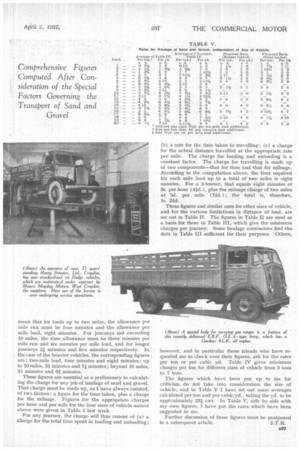Basic Charges for Sand Haulage
Page 40

Page 41

If you've noticed an error in this article please click here to report it so we can fix it.
ISHOULD like, before continuing this series of articles dealing with the haulage of sand and gravel, to state that, in my view, it ought to be unnecessary. The booklet on that subject published by the Ballast, Sand and Allied Trades Association could (and should), in my opinion, be accepted as a standard. It is undoubtedly the most practical and useful publication that any of the associations has yet issued. It contains all the information necessary to enable hauliers in this industry to stabilize rates for gravel haulage throughout the country.
I, personally, am at a loss to understand why so many sub-areas are spending time and taking trouble to draft basic rates for the haulage of sand and gravel, when the work has already been done in .a manner which is as near perfection as we are ever likely to approach.
However, as there seem to be so many who are reluctant to accept these rates, I will continue. In considering the problem, the following factors must be taken into account, in addition to those of cost and charges per hour and per mile set out at length in the previous article: terminal delays • and the varying speeds over journeys, the average speed differing according " to the lead.
So far as terminal delays are concerned, the B.S.A.T.A. wisely takes into consideration the two extremes of good. and bad loading. In this way, minimum and maximum rates are computed, leaving the haulier, to determine the point between these extremes which meets the requirements of any particular job. The Association appears to prefer to base its rates on an average. A quarter of an hour is allowed for each operation of. loading . and . unloading a 3-tonner, • 17 minutes for a 4-tonner, 20 minutes for a 5-tonner and 25 minutes for a 7-tormer. For each journey there must • Add not less than 41/.-A. per tan for each additional mile lead. t Add net less than 3.1/2d. per ton let each additional mile lead. 7 Ark' not less than 31/214. per ten for each additional mile lead. i Add not less than 314d. per ton for each additional mile lead. be an allowance of half an hour standing time for a 3-tormer ; for a 4-tonner, 35 minutes ; a 5-tonner, 40 minutes ; and a 7-tonner, 50 minutes.
Consideration of speed comes next. For leads not exceeding two miles, the maximum is 15 m.p.h. For leads up to 10 miles, the figure is 16 m.p.h. in the case of vehicles weighing over 21 tons unladen, and 20 m.p.h. for the lighter-type machines. For journeys in excess of 10 miles, it is reasonable to take 18 m.p.h. and 24 m.p.h. respectively for these two types of vehicle.
These speeds are important, because we have to take. them into consideration in assessing the total time for a particular journey. In the case of lighter vehicles, they
mean that for leads up to two miles, the allowance per mile run must be four minutes and the allowance per mile lead, eight minutes. For journeys not exceeding 10 miles, the time allowance must be three minutes per mile run and six minutes per mile lead, and for longer journeys 21 minutes and five minutes respectively. In the case of the heavier vehicles, the corresponding figures arc: two-mile lead, four minutes and eight minutes ; up to 10 miles, 31 minutes and 7i minutes ; beyond 10 miles,
minutes and 6i minutes.
These figures are essential as a preliminary to calculating the charge for any job of haulage of sand and gravel. That charge must be made up, as I have always insisted, of tw3 factors : a figure for the time taken, plus a charge for the mileage. Figures for the appropriate charges per hour and per mile for the four sizes of vehicle named above were given in Table I last week.
For any journey, the charge will thus consist of (a) a charge for the total time spent in loading and unloading;
(b) a rate for the time taken in travelling ; (c) a charge for the actual distance travelled at the appropriate rate per mile. The charge for loading and unloading is a constant factor. The charge for travelling is made up of two components—that for time and that for mileage. According to the computation above, the time required for each mile lead up to a total of two miles is eight minutes. For a 3-tonner, that equals eight minutes at 32. per hour (41d.), plus the mileage charge of two miles at 5d. per mile (10d.) ; the total is, therefore, Is. 21d.
These figures and similar ones for other sizes of vehicle, and for the various limitations in distance of lead, are set out in Table II. The figures in Table II are used as a basis for those in Table III, which give the minimum charges per journey. Some haulage contractors find the data in Table III sufficient for their purposes. Others, however, and in particular those friends who have requested me to check over their figures, ask for the rates per ton or per cubic yd. Table IV gives minimum charges per ton for different sizes of vehicle from 3 tons to 7 tons.
The figures which have been put up to me for criticism do not take into consideration the size of vehicle, and in Table V I have set out some averages calculated per ton and per cubic yd., taking the yd. to be approximately 23i cwt. In Table V, side by side with my own figures, I have put the rates which have been suggested to me.
Further discussion of these figures must be postponed to a subsequent article. S.T.R.




























































































